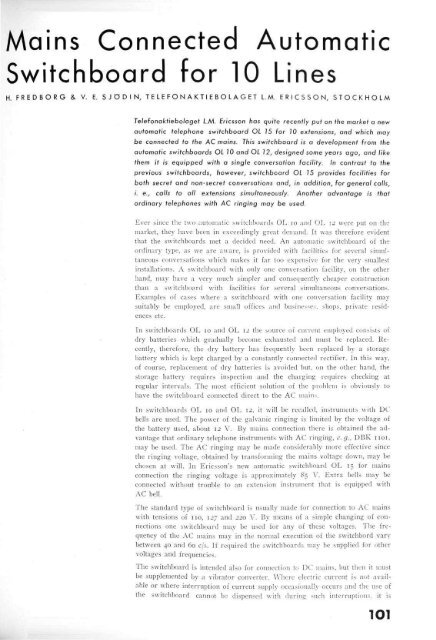ericsson review - History of Ericsson - History of Ericsson
ericsson review - History of Ericsson - History of Ericsson
ericsson review - History of Ericsson - History of Ericsson
Create successful ePaper yourself
Turn your PDF publications into a flip-book with our unique Google optimized e-Paper software.
Mains Connected Automatic<br />
Switchboard for 10 Lines<br />
H. FREDBORG & V. E. SJODIN, TELEFONAKTIEBOLAGET L.M. ERICSSON, STOCKHOLM<br />
Telefonaktiebolaget L.M. <strong>Ericsson</strong> has quite recently put on the market a new<br />
automatic telephone switchboard OL 15 for 10 extensions, and which may<br />
be connected to the AC mains. This switchboard is a development from the<br />
automatic switchboards OL 10 and OL 12, designed some years ago, and like<br />
them it is equipped with a single conversation facility. In contrast to the<br />
previous switchboards, however, switchboard OL 15 provides facilities for<br />
both secret and non-secret conversations and, in addition, for general calls,<br />
i. e., calls to all extensions simultaneously. Another advantage is that<br />
ordinary telephones with AC ringing may be used.<br />
Ever since the two automatic switchboards OL io and OL 12 were put on the<br />
market, they have been in exceedingly great demand. It was therefore evident<br />
that the switchboards met a decided need. An automatic switchboard <strong>of</strong> the<br />
ordinary type, as we are aware, is provided with facilities for several simultaneous<br />
conversations which makes it far too expensive for the very smallest<br />
installations. A switchboard with only one conversation facility, on the other<br />
hand, may have a very much simpler and consequently cheaper construction<br />
than a switchboard with facilities for several simultaneous conversations.<br />
Examples <strong>of</strong> cases where a switchboard with one conversation facility may<br />
suitably be employed, are small <strong>of</strong>fices and businesses, shops, private residences<br />
etc.<br />
In switchboards OL io and OL 12 the source <strong>of</strong> current employed consists <strong>of</strong><br />
dry batteries which gradually become exhausted and must be replaced. Recently,<br />
therefore, the dry battery has frequently been replaced by a storage<br />
battery which is kept charged by a constantly connected rectifier. In this way,<br />
<strong>of</strong> course, replacement <strong>of</strong> dry batteries is avoided but. on the other hand, the<br />
storage battery requires inspection and the charging requires checking at<br />
regular intervals. The most efficient solution <strong>of</strong> the problem is obviously to<br />
have the switchboard connected direct to the AC mains.<br />
In switchboards OL io and OL 12, it will be recalled, instruments with DC<br />
bells are used. The power <strong>of</strong> the galvanic ringing is limited by the voltage <strong>of</strong><br />
the battery used, about 12 V. By mains connection there is obtained the advantage<br />
that ordinary telephone instruments with AC ringing, e. g., DBK IIOI,<br />
may be used. The AC ringing may be made considerably more effective since<br />
the ringing voltage, obtained by transforming the mains voltage down, may be<br />
chosen at will. In <strong>Ericsson</strong>'s new automatic switchboard OL 15 for mains<br />
connection the ringing voltage is approximately 85 V. Extra bells may be<br />
connected without trouble to an extension instrument that is equipped with<br />
AC bell.<br />
The standard type <strong>of</strong> switchboard is usually made for connection to AC mains<br />
with tensions <strong>of</strong> no, 127 and 220 V. By means <strong>of</strong> a simple changing <strong>of</strong> connections<br />
one switchboard may be used for any <strong>of</strong> these voltages. The frequency<br />
<strong>of</strong> the AC mains may in the normal execution <strong>of</strong> the switchbord vary<br />
between 40 and 60 c/s. If required the switchboards may be supplied for other<br />
voltages and frequencies.<br />
The switchboard is intended also for connection to DC mains, but then it must<br />
be supplemented by a vibrator converter. Where electric current is not available<br />
or where interruption <strong>of</strong> current supply occasionally occurs and the use <strong>of</strong><br />
the switchboard cannot be dispensed with during such interruptions, it is<br />
101
















